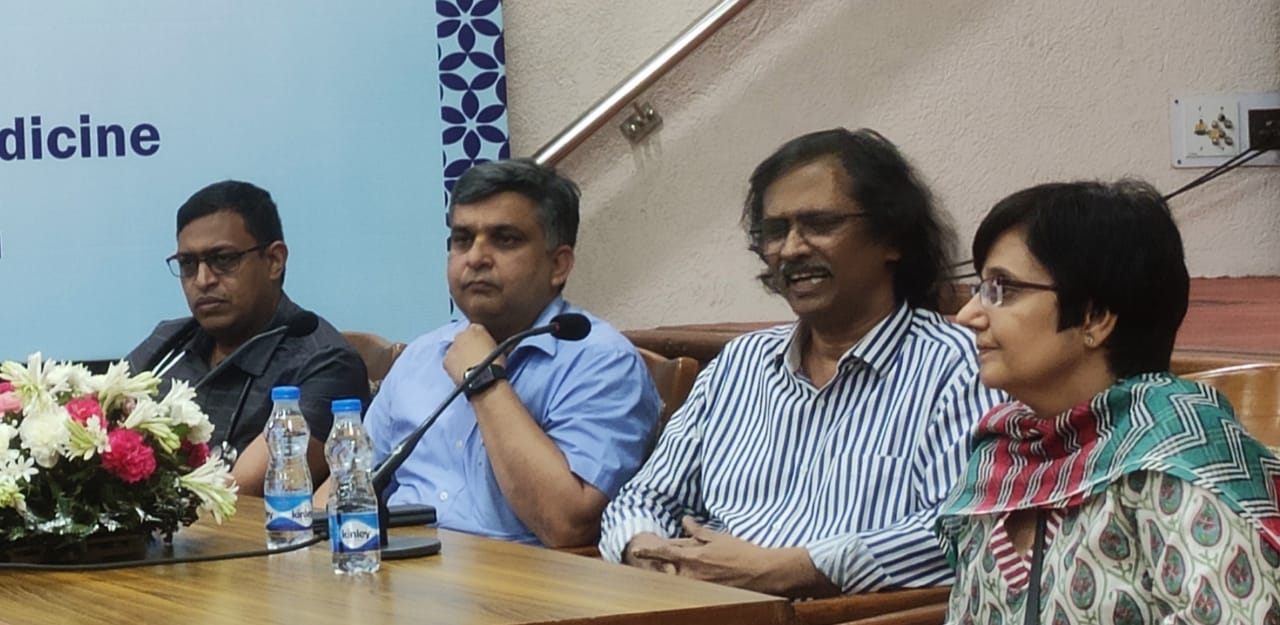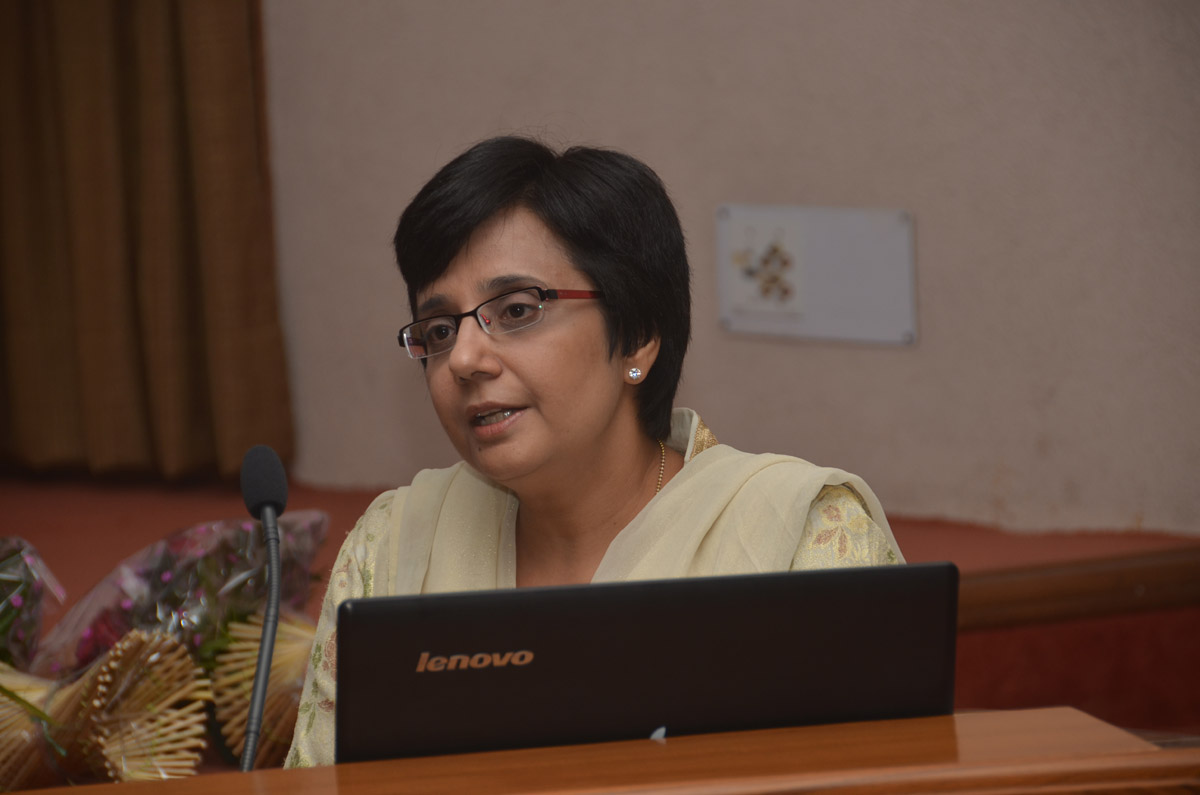
.jpg)
Scleroderma: Patient Awareness Month, an Initiative by PGIMER
Chandigarh: June 17, 2023: (Kartika Singh/Arth Parkash)::
Life poses many difficulties to us some of them are in the form of diseases. So when we are faced with a problem or a disease we have no option but to face it, solve it, or try to treat it. Scleroderma or Systemic sclerosis (SSc) is one such rare disease. And it may not respond easily at times. This disease is also called crest syndrome.
It is characterized by the deposition of excess collagen in the skin and internal organs due to vasculopathy, immune activation, and fibrosis. It can be classified by the extent of skin involvement, autoantibody profile, and pattern of organ involvement. Diffuse cutaneous SSc with organ involvement has a poorer prognosis than limited SSc. It also causes discolouring and tightening of the skin.
 More than 150 Patients attended the Awareness Program:
More than 150 Patients attended the Awareness Program:
The patient awareness program at PGIMER was attended by over 150 patients. They were told about various manifestations of the disease.
'It's a Condition of Living with the Disease', said the Speaker:
The invited speaker for the session was Dr Chandershekhar, president-elect of the Indian Rheumatology Association from Bengaluru. He spoke about how to cope with chronic diseases. He suggests the first step is to accept the disease and then comply with the treatment, as advised by the specialist. He explained, "This condition has multiple stages, from skin discolouring to Lung screening, from tightening of blood vessels to Neurological symptoms to joints, difficulty in breathing and blood pressure."

Regarding the longitudinal time process, Dr Chandrashkhar said, "As this disease can affect any organ. There isn't a special cause behind it. Rapid to Gradual deterioration of the organs and systems are present. Each time the patient takes the medication, it will get robust. It could be called a Living with Screlodermas or Disease Condition. But we must accept it, understand it and then get proper medication and treatment from a Specialist in Rheumatology, because it's an auto-immune disease, which will affect, our Immune System, to Neurological System, to Endocrinal System, all of them will be having an impact on one another."
Treatment is costly, still, No Insurence Company provides a claim under Screlodermas, said Dr ChandraShekhar:
While discussing about the Economical Aspect of patients, he said, "The treatment is costly, which includes 4000-6000 per month, per patient. Even for upper-middle-class families, this is a huge amount. The Insurance Companies don't even insure it under their health claim schemes. We are trying to get it to work out while having the support of Govt. of India." He added, "Moreover, It does have a psychological effect on the patients as well, which requires them to go for counselling or therapy. We in Banglore, provide free-of-cost counselling to patients having this particular condition, and we'll keep on working towards them as a whole."
A Special Website Dedicated to Scleroderma by PGIMER
 There is a special Scleroderma Patient WhatsApp group and a Scleroderma website www.scleroderma india.com.
There is a special Scleroderma Patient WhatsApp group and a Scleroderma website www.scleroderma india.com.
The Clinical Immunology and Rheumatology unit in the Department of Internal Medicine is involved in research. Many drugs are been repurposed for this disease and have been found to be useful, recently tacrolimus has been used in scleroderma ILD with encouraging results.
There was a panel discussion which was held by Dr Aman Sharma, Dr Shefali K Sharma, Dr Varun Dhir and Dr Shankar Naidu from the Department of Internal Medicine, PGIMER. Patients asked their questions and queries and they were aptly answered by the experts.
Women are more Prone to it than Men:
Dr. Shefali Khanna Sharma, (Deptt. of Internal Medicine, PGIMER, CHD), who had been researching and working on the treatment of patients having Scleroderma for more than 8 years. She said, "Currently we are having around 600+ patients with this rare disease. All of them are on a follow-up basis for the past 10-15 years. Women from the age group of 20-50 have it 3-4 times more than men. Medicinal treatments are available, but It's a chronic disease, which needs a patient to take continuous medication throughout life. The speed of healing varies from patient to patient. Medication does cause 2000-3000 Rupees, per person, per month; which do have a certain amount of economic barrier in following up the proper course."
While explaining the condition, she stated, "It's an auto-immune disease, which involves tightening and thickening of the skin, which also cause special damage to internal organs, blood vessels and nervous system."
Besides, she also spoke about the awareness program, to educate people regarding this disease and its early diagnosis. "We are having an awareness program along with a website in various languages dedicated to scleroderma. We are having treatment for this condition at PGI. We are also requesting the pharmaceuticals to provide less expensive drugs for the patients. We want more and more people to know about this condition and have their treatment at an early stage."
About Screlodermas:
Classification:
1. Based on the extent of skin involvement:
a. Diffuse cutaneous scleroderma: Skin thickening present on the trunk, face and other parts of the body.
b. Limited cutaneous scleroderma: Skin thickening is limited to sites distal to the elbows and knees, and may involve the face and neck.
c. Sine scleroderma: Internal organ manifestations, without detectable skin changes.
d. Overlap syndrome: Occurring concomitantly with systemic lupus erythematosus, inflammatory muscle disease or rheumatoid arthritis.
e. Cancer-associated dcSSc: Another group that develops cancer.
The etiology of the disease is not certain some say it is due to genetic factors, or environmental factors: like silica, heavy metals like mercury, organic chemicals vinyl chloride, benzene, toluene, trichloroethylene; drugs (bleomycin, pentazocin, taxol, cocaine; appetite suppressants like L tryptophan, mazindol, fenfluramine, diethylpropion) have been implicated. Infectious agents: Cytomegalovirus and Epstein Barr virus probably play a role due to molecular mimicry.
2. Clinical Features:
Raynaud’s phenomenon It is bluish discolouration of the fingers especially in response to cold. There is a loss of digital pulp-acro-osteolysis on radiographs and pitting scars over the fingertips.
a. Skin involvement: It consists of three stages: edematous phase, indurative phase and atrophic phase. The edematous phase is characterized by a stiff hand; subsequently, skin appears thick and tight, tendon fibrosis results in contractures and finally thin atrophic skin. Tendon fibrosis results in joint contractures. Perioral fibrosis leads to pursed lips, puckered mouth, pinched nose and mask-like face.
In the hand's tight skin limits full extension, contractures gradually develop, and ulcers appear on the volar pads of finger tips. Skin losses hair, oil and sweat glands and appears dry and coarse.
b. Musculoskeletal features:
Significant arthralgia with morning stiffness is characteristic. Muscle weakness may be secondary to disuse atrophy or there may be a mild proximal muscle weakness with mild muscle enzyme elevation and electromyographic (EMG) abnormalities. Subcutaneous calcification over the fingers, olecranon and prepatellar bursae is seen.
c. Gastrointestinal involvement: Difficulty in swallowing is the most common complaint. The feeling of satiety, intermittent bloating, abdominal cramps, chronic diarrhoea, constipation, obstipation, rectal prolapse and faecal incontinence are other features.
d. Pulmonary manifestations: Progressive exertional dyspnoea and nonproductive cough are typical features of pulmonary fibrosis. Structural abnormalities on high-resolution CT– include ground glass opacities which may be seen even in asymptomatic patients.
Cardiac involvement Although cardiac disease is a major clinical cause of death in SSc, it is apparent only in 10%.
e. Renal involvement: Scleroderma renal crisis (SRC) occurs in 10% of patients with diffuse scleroderma. Patients treated with high-dose glucocorticoids are at the greatest risk. It is characterized by the sudden onset of malignant hypertension, renal failure, haemolytic anaemia, and proteinuria.
Do’s and Don’t’s:
Raynaud’s :
Most of the patients suffer from Raynaud’s phenomenon. So protection from cold is very important.
Digital Ulcerations are common. And digital ulcers take longer than normal to heal
Adequate care of extremities is required.
GI symptoms:
Small frequent meals
Early and light dinner
If gastroesophageal reflux persists then elevation of the head end of the bed is helpful.
Skin symptoms:
Creams, Vaseline oils like coconut oil can be used to lubricate the skin
If the skin is itchy then anti-allergic can be taken with medical advice.
Breathlessness:
Patients can feel breathless on exertion. It is important to consult a doctor for this complaint. Also, sudden increases in breathlessness should be investigated.
Some patients who have advanced ILD may need domiciliary oxygen therapy.
Renal Involvement:
Blood pressure should be kept under control.
Corticosteroids should not be given unnecessarily
Renal function tests should be routinely performed
.jpeg) Scleroderma is a rare disease. The website- www.sclerodermaindia.com is an attempt to increase awareness about Scleroderma for patients who are suffering from this poorly understood disease. We would want that this website works as an interface between doctors and patients. And helps patients to understand the disease, accelerate the diagnosis and assure you that they are not the only ones suffering from the disease.
Scleroderma is a rare disease. The website- www.sclerodermaindia.com is an attempt to increase awareness about Scleroderma for patients who are suffering from this poorly understood disease. We would want that this website works as an interface between doctors and patients. And helps patients to understand the disease, accelerate the diagnosis and assure you that they are not the only ones suffering from the disease.
Besides monitoring patients closely we also repurpose drugs used in other autoimmune diseases and use them for Scleroderma with encouraging results